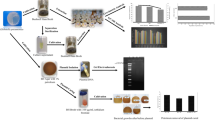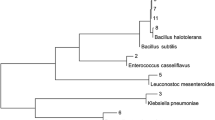Abstract
The removal of petroleum and petroleum-based products from the environment is of great importance. The objectives of this study were to investigate the most suitable physiological conditions and the effects of additional carbon, nitrogen and surfactant sources on petroleum biodegradation by Klebsiella pneumoniae ATCC13883 isolated from drilling fluid and to evaluate petroleum biodegradation with detailed hydrocarbon analysis by GC–MS. The results indicated that the highest biodegradation rate of 66.5% for K. pneumoniae was obtained under the conditions of pH 7, petroleum concentration 1% (v/v) and 7-day incubation at 150 rpm and 25 °C, proving to be the most effective physical conditions for petroleum biodegradation in this present study. Additional sources such as Triton X: 100, glucose and yeast extract significantly enhanced the petroleum biodegradation of K. pneumoniae to 68, 71 and 72.5%, respectively. In the last stage of this study, biodegradation rates were above 90% for hydrocarbons ranging from C10 and C20, above 70% for hydrocarbons ranging from C21 and C22 and above 40% for hydrocarbons ranging from C31 and C32. In conclusion, oil field adapted K. pneumoniae could efficiently degrade short-, medium- and long-chain alkanes in petroleum and thus is a potential source for advanced petroleum treatment.







Similar content being viewed by others
References
Afifi A, Motamedi H, Alizadeh B, Leilavi H (2015) Isolation and identification of oil degrading bacteria from oil sludge in Abadan oil refinery. Environ Exp Biol 13:13–18
Agwu OA, Ilori MO, Nwachukwu SU (2013) Utilization of drilling fluid base oil hydrocarbons by microorganisms isolated from diesel polluted soil. Soil Sediment Contam 22:817–828
Akpe AR, Ekundayo AO, Esumeh FI (2013) Degradation of crude oil bacteria: a role for plasmid borne genes. Global J Sci Front Res Biol Sci 13:20–26
Ali HR, El-Gendy NS, Moustafa YM, Roushdy MI, Hashem AI (2012) Degradation of asphaltenic fraction by locally isolated halotolerant bacterial strains. ISRN Soil Sci 2012:1–11
Al-Sayegh A, Al-Wahaibi Y, Al-Bahry S, Elshafie A, Al-Bemani A, Joshi S (2015) Microbial enhanced heavy crude oil recovery through biodegradation using bacterial isolates from an Omani oil field. Microb Cell Fact 14:141–152
Al-Wasify RS, Hamed SR (2014) Bacterial biodegradation of crude oil using local isolates. Int J Bacteriol 2014:1–8. doi:10.1155/2014/863272
Avdalovic J, Duric A, Miletic S, Ilic M, Milic J, Vrvic MM (2016) Treatment of mud pit by bioremediation. Waste Manag Res 34:734–739
Berekeea MM (2013) Towards efficient crude oil degradation by Pseudomonas sp. strain-O2: application of Plackett-Burman design for evaluation of cultivation conditions. Afr J Microbiol Res 7:4722–4729
Biodia ED, Montagnolli RN, Lopes PRM (2010) Microbial biodegradation potential of hydrocarbons evaluated by colorimetrik teqnique: a case study. In: Mendez-Vilas A (ed) Current research, technology and education topics in applied microbiology and microbial biotechnology, vol 2. FORMATEX, Badajoz, pp 1277–1288
Boboye B, Olukunle OF, Adetuyi FC (2010) Degradative activity of bacteria isolated from hydrocarbon polluted site in Ilaje, Ondo State, Nigeria. Afr J Microbiol Res 4:2484–2491
Boszczyk-Maleszak H, Zabost A, Wolicka D, Kacieszczenko J (2006) Effectiveness of biodegradation of petroleum products by mixed bacterial populations in liquid medium at differen pH values. Pol J Microbiol 55:69–73
Darvishi P, Mowla D, Ayatollahi S, Niazi A (2011) Biodegradation of heavy crude oil in wastewater by an efficient strain, ERCPPI-1. Desalin Water Treat 28:46–54
Das N, Chandran P (2011) Microbial degradation of petroleum hydrocarbon contaminants: an overview. Biotechnol Res Int 2011:1–13
Dasgupta D, Ghosh R, Sengupta TK (2013) Biofilm-mediated enhanced crude oil degradation by newly isolated Pseudomonas species. ISRN Biotechnol 2013:1–13. doi:10.5402/2013/250749
Demirbas A, Taylan O (2016) Removing of resins from crude oils. Petrol Sci Technol 34:771–777
Efeovbokhan VE, Hymore FK, Ayoola AA, Adeeyo OA (2014) Comparison of aerobic and anaerobic bioremediation of polluted water samples. Am Int J Contemp Res 4:120–126
El-Sheshtawy HS, Ahmed W (2017) Bioremediation of crude oil by Bacillus licheniformis in the presence of different concentration nanoparticles and produced biosurfactant. Int J Environ Sci Technol 14:1603–1614
Eraydin Erdogan E, Sahin F, Karaca A (2012) Determination of petroleum degrading bacteria isolated from crude oil contaminated soil in Turkey. Afr J Biotechnol 11:4853–4859
Farag S, Soliman NA (2011) Biodegradation of crude petroleum oil and environmental pollutants by Candida tropicalis strain. Braz Arch Biol Technol 54:821–830
Ferradji FZ, Mnif S, Badis A, Rebbani S, Fodil D, Eddouaouda K, Sayadi S (2014) Naphthalene and crude oil degradation by biosurfactant producing Streptomyces spp. isolated from Mitidja plain soil (North of Algeria). Int Biodeterior Biodegrad 86:300–308
Gao H, Zhang J, Lai H, Xue Q (2017) Degradation of asphaltenes by two Pseudomonas aeruginosa strains and their effects on physicochemical properties of crude oil. Int Biodeterior Biodegr 122:12–22
Garapati VK, Mishra S (2012) Hydrocarbon degradation using fungal isolate: nutrients optimized by combined grey relational analysis. Int J Eng Res Appl 2:390–399
Hamzah A, Rabu A, Raja Azmy RFH, Youssoff NA (2010) Isolation and characterization of bacteria degrading Sumandak and South Angsi Oils. Sains Malays 39:161–168
Hassan SED, Desouky SE, Fouda A, El-Gamal MS, Alemam A (2015) Biodegradation of phenanthrene by Klebsiella sp. isolated from organic contaminated sediment. J Adv Biol Biotechnol 4:1–12
Hassanshahian M, Emtiazi G, Cappello S (2012) Isolation and characterization of crude-oil degrading bacteria from the Persian Gulf and Capian Sea. Mar Pollut Bull 64:7–12
Jain RM, Mody K, Joshi N, Mishra A, Jha B (2013) Production and structural characterization of biosurfactant produced by alkalaphilic bacterium Klebsiella sp.: evaluation of different carbon sources. Colloid Surface B 108:199–204
Jalilzadeh Yengejeh R, Sekhavatjou MS, Maktabi P, Arbab Soleimani N, Khadivi S, Pourjafarian V (2014) The biodegradation of crude oil by Bacillus subtilis isolated from contaminated soil in hot weather areas. Int J Environ Res 8:509–514
Kaczorek E, Olszanowski A (2011) Uptake of hydrocarbon by Pseudomonas flourescens (P1) and Pseudomonas putida (K1) Strains in the presence of biosurfactants: a cell surface modification. Water Air Soil Pollut 214:451–459
Khan SA, Hamayun M, Khan AL, Ahmad B, Ahmed S, Lee IJ (2009) Influence of pH, temperature and glucose on biodegradation of 4-aminophenol by a novel bacterial strain, Pseudomonas sp. ST-4. Afr J Biotechnol 8:3827–3831
Kishore RSK, Kiese S, Fischer S, Pappenberger A, Grauschopf U, Mahler HC (2011) The degradation of polysorbates 20 and 80 and its potential impact on stability of biotherapeutics. Pharm Res 28:1194–1210
Kulkarni SV, Palande AS, Deshpande MV (2012) Bioremediation of petroleum hydrocarbons in soils. In: Satyanarayana T, Johri BN, Prakash A (eds) Microorganisms in environmental management: microbes and environment. Springer, London, Newyork
Kvendolven KA, Cooper CK (2003) Natural seepage of crude oil into the marine environment. Geo-Mar Lett 23:140–146
Linda A, Bouziane A (2012) Petroleum-oil biodegradation by Corynebacterium aquaticum ana Pseudomonas aeruginosa strains isolated from the industrial rejection of the refinery of ARZEWi-Algeria. World Appl Sci J 18:1119–1123
Marchand C, St-Arnaud M, Hogland W, Bell TH (2017) Petroleum biodegradation capacity of bacteria and fungi isolated from petroleum-contaminated soil. Int Biodeterior Biodegrad 116:48–57
Mittal A, Singh P (2009) Isolation of hydrocarbon degrading bacteria from soils contaminated with crude oil spills. Indian J Exp Biol 47:760–765
Mohanty G, Mukherji S (2008) Biodegradation rate of diesel range n-alkanes by bacterial cultures Exiguobacterium aurantiacum and Burkholderia cepacia. Int Biodeterior Biodegrad 61:240–250
Mrozik A, Piotrowska-Seget Z (2010) Bioaugmentation as a strategy for cleaning up of soils contaminated with aromatic compounds. Microbiol Res 162:363–375
Plaza G, Ulfig K, Hazen TC, Brigmon RL (2001) Use of molecular techniques in bioremediation. Acta Microbiol Pol 50:205–218
Rahman KSM, Thahira-Rahman J, Lakshmanaperumalsamy P, Banat IM (2002) Towards efficient crude oil biodegradation by a mixed bacterial consortium. Bioresour Technol 85:257–261
Raza C, Bilal A, Jahan N (2010) Evaluation of biodegradation potential of bacteria in crude oil contaminated soil. Biologia 56:77–85
Sajna KV, Sukumaran RK, Gottumukkala LD, Pandey A (2015) Crude oil biodegradation aided by biosurfactants from Pseudozyma sp. NII 08165 or its culture broth. Bioresour Technol 191:133–139
Salam LB, Obayori OS, Akashoro OS, Okogie GO (2011) Biodegradation of bonny light crude oil by bacteria isolated from contaminated soil. Int J Agric Biol 13:245–250
Sathiskumar M, Binupriya AR, Baik SH, Yun SE (2008) Biodegradation of crude oil by individual bacterial strains and a mixed bacterial consortium isolated from hydrocarbon contaminated areas. Clean J 36:92–96
Sawadogo A, Harmonie OC, Sawadogo JB, Kabore A (2014) Isolation and characterization of hydrocarbon-degrading bacteria from wastewaters in Ouagadougou, Burkina Faso. J Environ Prot 5:1183–1196
Semple KT, Redi BJ, Fermor TR (2001) Impact of composting strategies on the treatment of soils contaminated with organic pollutants. Environ Pollut 112:269–283
Sharma D, Ansari MJ, Al-Ghamdi A, Adgaba N, Khan KA, Pruthi V, Al-Waili N (2015) Biosurfactant production by Pseudomonas aeruginosa DSVP20 isolated from petroleum hydrocarbon-contaminated soil and its physicochemical characterization. Environ Sci Pollut Res 22:17636–17643
Singh K, Chandra S (2014) Treatment of petroleum hydrocarbon polluted environment through bioremediation: a rewiev. Pak J Biol Sci 17:1–8
Speight JG, Arjoon KK (eds) (2012) Energy and environment: bioremediation of petroleum and petroleum products. Scrivener Publishing LLC, Salem, Massachusetts
Struchtemeyer CG, Davis JP, Elshahed MS (2011) Influence of the drilling mud formulation process on the bacterial communities in thermogenic natural gas wells of the Barnett Shale. Appl Environ Microbiol 77:4744–4753
Thapa B, Kumar A, Ghimire A (2012) A rewiev on bioremediation of petroleum hydrocarbon contaminants on soil. Kathmandu Univ J Sci Eng Technol 8:167–170
The International Tanker Owners Pollution Federation Limites (ITOPF) (2012) Technical Information Booklet 8, 1–11. London, England. http://www.itopf.com
Tiwari B, Manickam N, Kumari S, Tiwari A (2016) Biodegradation and dissolution of polyaromatic hydrocarbons by Stenotrophomonas sp. Bioresour Technol 216:1102–1105
Turkiewicz A (2011) The role of microorganisms in the oil and gas industry. ROCZ OCHR SR Tom 13:227–240
Ubalua AO (2011) Bioremediation strategies for oil polluted marine ecosystem. Aust J Agric Eng 2:160–168
U.S. Environmental Protection Agency (1986) Test method for evaluating solid waste, SW-846, vol 1A, 3rd edn. U.S. EPA, Washington, DC
Vanishree M, Thatheyus AJ, Ramya D (2014) Biodegradation of petroleum using the fungus Penicillium sp. Sci Int 2:26–31
Varjani SJ (2017) Microbial degradation of petroleum hydrocarbons. Bioresour Technol 223:277–286
Varjani SJ, Upasani VN (2016) Biodegradation of petroleum hydrocarbons by oleophilic strain of Pseudomonas aeruginosa NCIM 5514. Bioresour Technol 222:195–201
Varjani SJ, Thaker MB, Upasani VN (2014) Optimization of growth conditions on native hydrocarbon utilizing bacterial consortium ‘Hubc’ obtained from petroleum pollutant contaminated sites. Indian J Appl Res 4:474–476
Varjani SJ, Rana DP, Jain AK, Bateja S, Upasani VN (2015) Synergistic ex situ biodegradation of crude oil by halotolerant bacterial consortium of indigenous strains isolated from on shore sites of Gujarat, India. Int Biodeterior Biodegrad 103:116–124
Acknowledgements
This work is a part of Ph.D. Thesis of S. Bilen Ozyurek and is supported by Hacettepe University Scientific Research Projects Coordination Unit (Project Number: FHD-2015-8871).
Author information
Authors and Affiliations
Corresponding author
Additional information
Editorial responsibility: Tanmoy Karak.
Rights and permissions
About this article
Cite this article
Bilen Ozyurek, S., Seyis Bilkay, I. Biodegradation of petroleum by Klebsiella pneumoniae isolated from drilling fluid. Int. J. Environ. Sci. Technol. 15, 2107–2116 (2018). https://doi.org/10.1007/s13762-017-1581-y
Received:
Revised:
Accepted:
Published:
Issue Date:
DOI: https://doi.org/10.1007/s13762-017-1581-y




